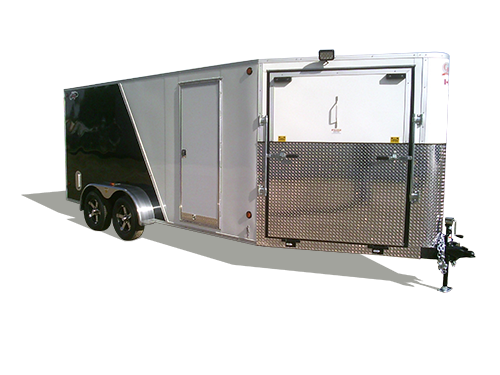THE FRAME
- Main frame and crossmember materials are carefully selected to match the GVWR of each model of trailers. Special consideration is given to the weight to strength ratio of all material to minimize overall trailer weight and optimize trailer carrying capacities. Crossmembers are on 16” centers.
- The interior wall and roof structure is comprised of HSS tubing. The tubing structure in the walls and roof provides a rigid skeleton frame that eliminates twisting and bending that can lead to premature fatigue and possible failure of welded areas. 16” centers on wall and ceiling.
- Metal inert gas (MIG) welding of all steel structural areas of the trailer ensures proper penetration and maximum strength of each weld.
THE SUSPENSION
-
Only torsion rubber ride axles are used on CJay trailers. CJay uses only axles manufactured in North America and as such parts are readily available when required. Downtime can be expensive and using brand name components can reduce these costs.
-
Torsion rubber ride axles eliminate springs, hangers, U-bolts, shackle straps and bolts that are potential wear items when using standard leaf spring suspensions. The torsion rubber ride axle uses four internal rubber blocks that provide the suspension requirements needed.
-
Radial tires and wheels are carefully selected to match the capacity of the axles allowing for proper load carrying. Tires are selected to offer maximum wear and load handling performance.
THE ELECTRICAL SYSTEM
- The main wiring harness is covered with a neoprene jacket. This protective jacket provides durability and flexibility in even the most extreme weather conditions. The electrical current is carried through the heavy gauge wiring to ensure proper lighting and braking requirements are met.
- The main wiring harness is secured to the main frame using a series of rubber insulated clamps. This method secures the main harness while it eliminates vibrations and premature wear without causing damage to the exterior of the neoprene jacketed harnesses thus increasing the life of the wiring harness.
- Electrical brake wires and lighting wires are protected in all exposed areas. Grommets and wiring protectors are used in any area where the wire could come into contact with sharp edges or around hole openings.
- All electrical connections are soldered and heat shrink sealed to provide maximum connection life and trouble free use. Premature wire corrosion can only be prevented using this proven method.
- Sealed junction boxes are used in various locations on the trailer providing weather resistant areas for electrical connections and ease of maintenance.
- Lights are sealed, rubber mounted and recessed, providing protection and years of trouble-free use. LED (light emitting diode) style lighting is a standard feature on all trailers.


THE ENCLOSURE
- .032 thickness of aluminum siding is used to cover the exterior of the trailer. The aluminum is pre-painted and offered in white, black, silver, blue, red or orange colours. The siding is secured to the trailer framing using a “VHB” bonding method.
- The “VHB” bonding eliminates the use of screws, rivets, welds or other fasteners that are commonly used to secure the exterior siding and provides a smooth wall finish. The “VHB” tape reduces vibrations, compensates for thermal expansion and contractions and provides for a uniform and consistent bonding surface.
- The roof area is covered with a one-piece aluminum sheet that is secured using the same “VHB” bonding method as the walls. The perimeter or edge of the roofing is also secured with screws and then a special sealant applied around the entire edge of the roof to provide maximum sealing.
- The walls are lined with 3/8” plywood and the floors are covered with ¾” plywood. The ¾” plywood is first glued to each crossmember and than screwed to provide extra strength and maximum sealing.
THE LITTLE THINGS MATTER
- Each trailer is cleaned prior to painting using an acid wash system that removes grease, oil and other contaminates that can cause paint adhesion problems such as flaking and peeling leading to rust problems. A final phosphate rinse, which further promotes paint and primer adhesion, is applied prior to the actual painting procedure.
- The two-part polyurethane paint and primer is applied using an electrostatic painting system. This style of painting method applies an actual electrical current or charge to the material that then allows the primer and paint to literally wrap around the material to ensure for maximum primer/paint coverage in all areas, not just the ones you can see.
- As a final step to maximize trailer life and minimize potential leakage, the underside of each trailer is covered with an automotive style rubberized undercoating material. This protective coating protects the mainframe, crossmembers and the floor area of all trailers.
